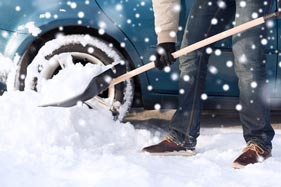Snowy weather is on its way, and Long & Foster Insurance, a leading independent insurance agency that represents many of the nation’s top rated insurance companies, advises drivers to prepare themselves for the possible hazards of commuting in winter storms. Auto accident claims have been shown to increase in frequency during cooler months, according to research by Travelers, one of Long & Foster Insurance’s providers, so it’s critical to prepare for the season ahead.
“Snow storms, sleet and icy conditions—all common occurrences across the Mid-Atlantic and Northeast during the winter—present a particular set of driving hazards for both new and experienced motorists,” said Patrick Bain, president of Long & Foster Insurance. “The keys to safe driving in the winter are not only preparing your vehicle for the season, but also educating yourself on how to react in severe conditions and on what to do should you get stranded during a snowstorm or other weather emergency.”
Below are a few of Long & Foster Insurance’s recommendations to help avoid an accident during the cold winter months.
Be prepared before a storm hits.
-
Have a mechanic check your car’s battery, brakes, fluid levels (antifreeze, windshield washer fluid and oil), as well as the heating and exhaust systems to ensure that your car is in good, safe working condition.
-
Try to keep your gas tank full during the winter months. Don’t allow the gas to go below half a tank. Not only will this prevent damage from freezing, you’ll avoid running out of gas if you’re stuck in a traffic jam during the dead of winter.
-
Install snow tires or all-weather radials with adequate treads.
-
Keep an emergency supply kit, including blankets, flares, a flashlight with extra batteries, and other necessities, in your trunk. You should also stock your car with material for survival, such as waterproof matches, a first aid kit, dry clothing, winter boots, gloves and a hat, and a brightly colored cloth (to tie to the antenna).
Keep these recommendations in mind when driving under adverse winter conditions.
-
Take care pulling out of streets blocked by mountains of snow. It’s often difficult to see who or what is coming.
-
Back your car into the driveway so you have better vision when pulling out.
-
Be aware of joggers on the street. Often sidewalks are impassable and die-hard joggers venture onto the street for a clearer path. Unfortunately, they may not see icy spots or other hazards hidden below the slush.
-
If your car does not have anti-lock brakes and you start skidding on the ice, try not to slam on your brakes. Gently pump your brakes to maintain better control and prevent your wheels from locking.
-
If your car has anti-lock brakes, slam on your brakes when skidding on ice. Pumping your brakes prevents the anti-lock system from taking over.
If you must travel during a severe storm,
-
Don’t travel alone. Notify someone of your estimated time of arrival, as well as your primary and alternate travel routes.
-
Stay in your car and wait for help if you get stuck. Run the engine and heater sparingly. Also make sure your exhaust pipe is clear of snow and ventilate your car so that carbon monoxide fumes won’t poison you.
-
Keep your energy. Eat food that provides the body with energy for producing its own heat. Replenish your body with fluids to prevent dehydration. Consider keeping packs of almonds or other nuts and drinking water in your vehicle for emergency use. Don’t eat snow; it will lower your body temperature. Melt it first.
For more information and quotes on insurance coverage, visit www.longandfoster.com/insurance.
